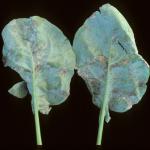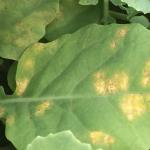Brassicas, Downy Mildew
Hyaloperonospora brassicae s.l.
Downy Mildew occurs wherever brassica crops are grown and infects cabbage, Brussels sprout, cauliflower, broccoli, kale, kohlrabi, Chinese cabbage, turnip, radish, and mustard as well as cruciferous weed species. The disease caused by Hyaloperonospora brassicae s.l. is particularly important on seedlings but can also cause poor growth and reduced yield and quality of produce at later plant stages. Plants can be infected at any stage of growth. Disease development is favored by cool, moist conditions, whether moisture is from rain, dew, or fog. Infections that occur early in a crop life cycle may be latent or dormant, only showing symptoms later in the season when conditions in the field are again favorable.
Identification:
Small, angular lesions develop on leaves and inflorescences. These lesions enlarge and become irregular, yellow to orange necrotic patches, with dense sporulation on leaf undersides. Heavy sporulation gives leaf undersides a gray to purple, downy appearance.
On seedlings, bright yellow, irregularly shaped spots appear on leaves. These yellow lesions have networks of black spots or lines throughout, looking almost like a web. Under cool, moist conditions you may see white cottony growth on the undersides of leaves. Yellowed leaves may drop. On older plants, these irregular yellow spots will become tan or gray papery patches. In cauliflower, dark gray spots may appear on the curd and, when cut open, gray streaking is noticeable on the branches beneath the florets. In broccoli, there may be no spots on the head but gray streaks may form beneath the beads, running all the way back to the main stem. In cabbage, black spots may be evident on the exterior of the head, or internal darkening and purplish spots may occur if the infection becomes systemic and the pathogen is able to move from the lower leaves into the stem and head. Turnip or radish roots may develop internal, irregularly shaped brown or black discoloration extending from the crown downward. In advanced stages, the skin becomes rough and the root may split open, which can be confused with symptoms of Rhizoctonia root rot. Disease can spread in storage and also may allow for entry of secondary rot pathogens.
Life Cycle:
Downy mildew overwinters on winter-sown host crops or cruciferous weeds. Infection of leaves and inflorescences results from sporangia produced on living hosts. Secondary sporangia are spread by wind and splashing water. Oospores, if produced, survive in crop residues and in the soil. There is some evidence that H. brassicae may be seed borne. The pathogen may survive in a latent state within these asymptomatic, systemically infected plants and become active when environmental conditions favor disease development. Secondary spread of the pathogen occurs by asexual spores (sporangia), which are produced when there is abundant moisture on leaves provided by dew, drizzling rain, or heavy fog. Sporangia carried on air currents and on wind-blown rain germinate on leaves and produce new infections. Sporulation, germination, and reinfection can occur in as few as four to five days. The pathogen is favored by cool, moist conditions.
Crop Injury:
On seedlings, cotyledons and hypocotyls may become infected and seedling loss can occur. In more mature plants, small, angular lesions develop on leaves and inflorescences. A pale brown to gray discoloration occurs on the surface of heads or curds and black streaks may develop on the stems. Affected tissues become susceptible to attack by secondary rotting organisms. Downy mildew also attacks the taproots of turnip and radish and infected organs develop a black, epidermal blotch and an internal discoloration.
Cultural Controls & Prevention:
- Removal of crop debris and weed hosts may reduce inoculum.
- Start with disease free seed - ask your seed supplier if the lot has been tested for downy mildew or hot water treat your seeds.
- Scout seedlings in the greenhouse and try to maintain low humidity.
- Practice rotation with non-brassica crops. A two-year rotation away from brassicas is an important management step.
- Manage Downy Mildew on transplants in the seedling bed by improving air circulation, irrigating early in the day, and applying fungicides.
- In the field, lower leaf wetness periods and humidity in the plant canopy by increasing spacing, controlling weeds, planting in the direction of prevailing winds, and planting in areas that get full sun.
- Plant resistant or tolerant cultivars. Some crops and cultivars are more susceptible than others, though the relative susceptibilities of crops and varieties has not been studied. Many universities and seed companies report that introduction of resistant cultivars is imminent, but none are currently available.
Chemical Controls & Pesticides:
For Current information on disease recommendations ins specific crops including information on chemical control & pesticide management, please visit the New England Vegetable Management Guide website.
Crops that are affected by this disease:
The Center for Agriculture, Food and the Environment and UMass Extension are equal opportunity providers and employers, United States Department of Agriculture cooperating. Contact your local Extension office for information on disability accommodations. Contact the State Center Director’s Office if you have concerns related to discrimination, 413-545-4800 or see ag.umass.edu/civil-rights-information.



